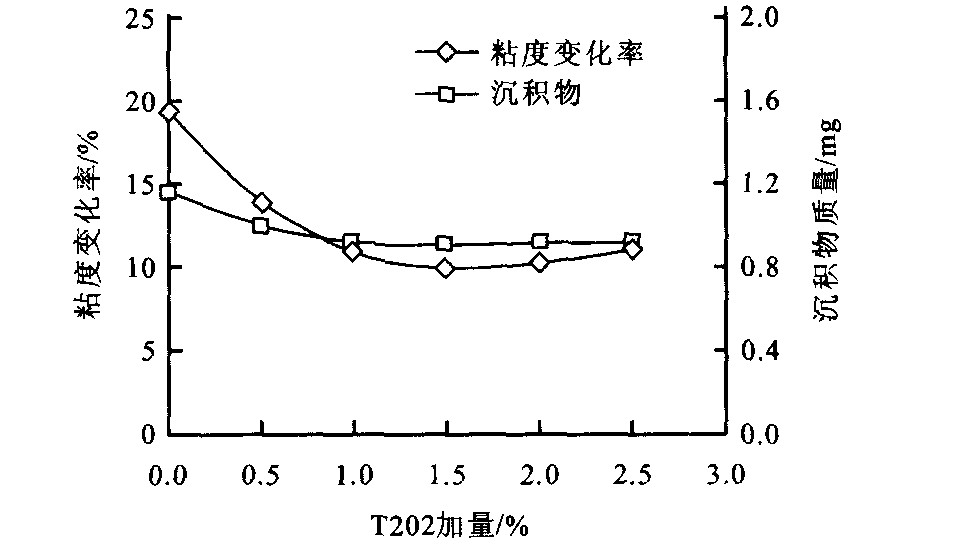Antioxidant and antiwear property of additives in vegetable base oil
-
摘要: 通过分析植物基基础油的生物降解性和使用性能的要求, 合理选用基础油及添加剂, 在均匀设计的基础上安排多因素多水平试验, 用逐步回归技术通过计算机对试验结果进行处理, 以此分析基础油对添加剂的感受性及添加剂的配伍性。在重点考察基础油的抗氧抗磨性的基础上, 得出复合添加剂的最佳配比为MT202∶MT203∶MT204∶MDNA∶MCuDTP∶MT115A∶MT152为2∶4∶8∶6∶1∶16∶24;最佳加量范围为3%~5%。最后进行了研制油与参比油的性能对比试验, 结果表明, 研制油的抗氧抗磨性优于同类矿物基润滑油, 而且可生物降解。Abstract: By analyzing the vegetable base oil demands on the lubrication mechanism and biodegradable performance, base oil and additives were chosen reasonably. The uniform design was used for arranging multi-level and multi-factor tests, and the stepwise technique was adopted to analyze the datum by computer.The sensitivity and compatibility among additives and base oil are studied by a series of tests.The optimal proportion and the amount of the additives are pointed out: MT202∶MT203∶ MT204∶ MDNA∶ MCuDTP∶ MT115A∶ MT152 is 2∶4∶8∶6∶1∶16∶24, their amount is among 3% to 5%. At last, several experiments were made to evaluate the property of formulation by comparing with petrolatum-based lubricant. The results show the former has better antioxidant and antiwear property, and it is biodegradable.
-
表 1 T202单剂试验
Table 1. Test of single T202
T202加量/% 0 0.5 1.0 1.5 2.0 2.5 粘度变化率/% 19.437 13.972 10.891 9.903 10.334 10.992 沉积物/mg 1.161 1.003 0.923 0.909 0.918 0.924 氧化前WSD/mm 0.662 0.484 0.401 0.412 0.393 0.405 氧化后WSD/mm 0.592 0.441 0.379 0.367 0.364 0.371 表 2 T203单剂试验
Table 2. Test of single T203
T203加量/% 0 0.5 1.0 1.5 2.0 2.5 粘度变化率/% 19.437 15.112 12.654 12.035 11.221 11.112 沉积物/mg 1.161 1.035 0.869 0.755 0.692 0.681 氧化前WSD/mm 0.662 0.519 0.442 0.406 0.379 0.354 氧化后WSD/mm 0.592 0.472 0.425 0.376 0.344 0.331 表 3 T204单剂试验
Table 3. Test of single T204
T204加量/% 0 0.5 1.0 1.5 2.0 2.5 粘度变化率/% 19.437 16.321 14.943 13.664 13.033 12.997 沉积物/mg 1.161 1.042 0.892 0.791 0.749 0.732 氧化前WSD/mm 0.662 0.589 0.533 0.510 0.482 0.456 氧化后WSD/mm 0.592 0.536 0.501 0.473 0.459 0.407 表 4 DNA单剂试验
Table 4. Test of single DNA
DNA加量/% 0 0.2 0.4 0.6 0.8 1.0 粘度变化率/% 19.437 20.631 22.931 23.931 16.217 14.346 沉积物/mg 1.161 1.156 1.150 1.112 1.075 1.013 氧化前WSD/mm 0.662 0.644 0.639 0.653 0.643 0.661 氧化后WSD/mm 0.596 0.584 0.576 0.577 0.592 0.609 表 5 CuDTP单剂试验
Table 5. Test of single CuDTP
CuDTP加量/% 0 0.2 0.4 0.6 0.8 1.0 粘度变化率/% 19.437 21.133 20.922 18.067 14.399 11.433 沉积物/mg 1.161 1.163 1.169 1.394 1.709 2.022 氧化前WSD/mm 0.662 0.519 0.397 0.331 0.330 0.332 氧化后WSD/mm 0.592 0.466 0.359 0.299 0.321 0.373 表 6 均匀试验设计
Table 6. Uniform design
No X1/% X2/% X3/% X4/% X5/% X6/% X7/% 1 0.10 0.25 0.55 0.55 0.80 7.5 8.0 2 0.25 0.55 1.15 0.95 0.60 6.5 7.5 3 0.40 0.85 1.75 0.50 0.40 5.5 7.0 4 0.55 1.15 2.35 0.90 0.20 4.5 6.5 5 0.70 1.45 0.40 0.45 0.85 3.5 6.0 6 0.85 1.75 1.00 0.35 0.65 2.5 5.5 7 1.00 2.05 1.60 0.40 0.45 1.5 5.0 8 1.15 2.35 2.20 0.80 0.25 0.5 4.5 9 1.30 0.10 0.25 0.35 0.90 8.0 4.0 10 1.45 0.40 0.85 0.75 0.70 7.0 3.5 11 1.60 0.70 1.45 0.30 0.50 6.0 3.0 12 1.75 1.00 2.05 0.70 0.30 5.0 2.5 13 1.90 1.30 0.10 0.25 0.95 4.0 2.0 14 2.05 1.60 0.70 0.65 0.75 3.0 1.5 15 2.20 1.90 1.30 0.20 0.55 2.0 1.0 16 2.35 2.20 1.90 0.60 0.35 1.0 0.5 表 7 均匀试验结果
Table 7. Result of uniform design
No 粘度变化率/% 沉积物/mg WSD/mm No 粘度变化率/% 沉积物/mg WSD/mm 1 7.93 0.417 0.398 9 6.34 0.743 0.370 2 10.87 0.599 0.394 10 9.31 0.554 0.358 3 3.79 0.632 0.372 11 8.25 0.483 0.356 4 2.74 0.625 0.369 12 8.22 0.452 0.353 5 13.98 0.404 0.328 13 6.52 0.632 0.315 6 15.83 0.523 0.324 14 6.73 0.567 0.312 7 10.41 0.601 0.321 15 7.12 0.477 0.307 8 7.87 0.732 0.318 16 7.02 0.439 0.304 表 8 标准化结果
Table 8. Standardization result
No 粘度变化率标准化 沉积物质量标准化 WSD标准化 总的标准化 1 0.396 5 0.038 3 1.000 0 0.373 9 2 0.621 1 0.575 2 0.957 4 0.678 9 3 0.080 2 0.672 6 0.723 4 0.445 8 4 0.000 0 0.185 8 0.191 5 0.112 6 5 0.878 5 0.000 0 0.255 3 0.394 5 6 1.000 0 0.351 2 0.212 8 0.583 3 7 0.585 9 0.581 1 0.170 2 0.500 9 8 0.391 9 0.967 6 0.148 9 0.573 6 9 0.275 0 1.000 0 0.702 1 0.650 4 10 0.501 9 0.442 5 0.574 5 0.492 6 11 0.420 9 0.233 6 0.553 2 0.372 2 12 0.418 6 0.141 6 0.521 3 0.328 3 13 0.287 2 0.672 6 0.117 9 0.407 3 14 0.302 5 0.480 8 0.085 1 0.330 4 15 0.325 4 0.215 3 0.319 0 0.222 7 16 0.327 1 0.103 2 0.000 0 0.172 1 表 9 最佳加量试验
Table 9. Test of optimal amount
No 加量/% 粘度变化率/% 沉积物质量/mg WSD/mm 1 0 19.437 0 1.161 0 0.662 0 2 1 5.786 1 0.753 3 0.419 9 3 2 4.674 9 0.643 7 0.345 4 4 3 3.352 0 0.513 7 0.298 0 5 4 3.879 4 0.399 0 0.311 6 6 5 4.057 5 0.429 4 0.345 4 7 6 4.472 9 0.519 8 0.413 2 8 7 4.710 6 0.571 6 0.440 2 表 10 研制油与参比油性能对比
Table 10. Comparison of two lubricants' properties
试验项目 研制油 参比油 粘度变化率/% 3.819 3.893 沉积物质量/mg 0.399 0.432 磨斑直径/mm 0.311 0.329 -
[1] Pegnoglou R. Additives for environmentally acceptable lubricant[J]. NLGI Spokesman, 1996, 60(6): 18-25. [2] Rebeccl G. Biodegradable lubricants[J]. Lubrication Engineering, 1998, 54(7): 10-16. [3] Arthur P. Some experiment with biodegradable lubricant[J]. NLGI Spokesman, 1996, 60(6): 9-12. [4] 王毓民. 汽车燃料、润滑油及其应用[M]. 北京: 人民交通出版社, 1994. [5] Texaco. The need for biodegradable lubricants[J]. Lubrication Tribology, 1992, 44(4): 6-7. doi: 10.1108/eb053419 [6] 王大璞. 绿色润滑油发展概况[J]. 摩擦学学报, 1999, 19(2): 181-186. https://www.cnki.com.cn/Article/CJFDTOTAL-MCXX902.018.htmWANG Da-pu. Developing status of green lubricating oil[J]. Tribology, 1999, 19(2): 181-186. (in Chinese) https://www.cnki.com.cn/Article/CJFDTOTAL-MCXX902.018.htm [7] 王汝霖. 润滑剂摩擦化学[M]. 北京: 中国石化出版社, 1994. [8] 方开泰. 正交与均匀试验设计[M]. 北京: 科学出版社, 2001. -





 下载:
下载:






